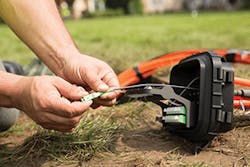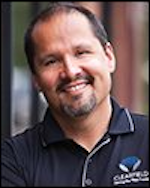The Journey to Create Fiber Solutions for the Future —
I always wanted a tree house as a kid. Why? Hello! Because it’s a tree house and that is just cool! From there, my uncle said, I could set up my own telephone system, consisting of 2 cups and a string. Wow — game changer! But there were rules. The string had to be un-touched along its route path from my tree house to the neighbor’s tree house. The distance between the two had to be limited because tension on the line allowed our sounds/sound waves to vibrate the bottom of the cup, transfer onto the string and vibrate the bottom of the cup on the other end, ultimately duplicating the sound. If the string touched anything, it dulled the signal or sound, and I might not be heard.
You see, my uncle worked for the Navy as a civilian electrical engineer after he served his time in WWII. At 10, he was one of the smartest men I knew. I learned a lot that summer as my uncle listened and applied real-world experience to every one of my inventions. I made several of the inventions work, and depending on the conditions, some worked better than others. I learned early on that there was always more than one way to do things. You just needed to be a dreamer and have some practical experience. We had more strings, rope, and wire, attached to every cup, can, paint can, speaker cone, and garbage can lid that you could imagine. You’d have thought you were walking into a huge spider web by the time we were done.
As you can imagine, I was blown away when he told me that the real world’s telephone was basically the same thing, except that electrical current replaced the sound waves on the string. That was the beginnings of a life-long endeavor in telecommunications. In many ways, the same challenges present themselves. When a game changing transmission media, full of bandwidth possibilities comes to life, the challenge becomes how to effectively get it from here to there. And back again.
Today, my world is surrounded by people equally brilliant as my uncle. My teams work hand-in-hand as ideas are developed and real-world applications are vetted against them. The Last Mile continues to be the final frontier for fiber delivery with many views on the best way to do it.
It has become clear that the methods used to deliver fiber media, from content origination (Central Office or Head-End) deeper into a fiber serving area, do not have the same economic model as we get closer and closer to the customer and fiber route paths and fiber counts are reduced to one. Yet, our industry continues to try and deploy those long-haul and Middle-Mile techniques to the Last Mile. Some work well because we have been doing them for the last 20 years, but they come at a cost. Others are cost-effective but have no long-term operational viability because they cannot be repaired easily. Yet, these are the considerations that impact first cost, restorability, local regulations, and ease of implementation, that vary from operator to operator. There is no single way to do this because the operational and construction initiatives vary — and sometimes within the same organization.
I think about the Last Mile drop every day. I wouldn’t say it keeps me up at night, but it definitely gets me up in the morning as I think Today is the day we will come up with a better way. Thankfully, there are multiple products and approaches that may fit the bill for the fiber networks being designed today.
Dreams, Dialog and Debate
Brian Schrand runs the application engineering group at our company and is instrumental in product development as a sounding board for product application environments and a real-world craft perspective. He, among many, helps me vet out the dumb ideas from the smart ones. The following are typical interactions between Brian and me during development phases:
Topic: First Cost
Johnny Hill: Of course I want to pay the lowest price possible. Who doesn’t?
Brian Schrand: Is the lowest cost always the best option? Building a network is getting from point A to point B, just like when you were a kid using cans and string. I’ve seen some very innovative approaches to constructing a fiber network, but each one needs the same basic things.
First you need to establish a right of way. This can be one of the biggest and most costly challenges to overcome. Once you’ve established the easement you’ll have to decide what type of pathway you’re going to choose: aerial or underground. Both have their advantages and disadvantages. Aerial is faster and easier to deploy but many times there is a recurring attachment cost that has to be paid to the owner of the utility poles. This can be significant over time.
Underground initially has a higher capital cost to install but won’t have the recurring attachment fees that aerial has. If you’ve chosen underground deployment, the next question is: to plow or directional bore? Boring is less disruptive than plowing but it is also more expensive.
Whatever the option chosen, each one has to be looked at closely to determine which will work best for the application at hand. Some things to consider are terrain, municipal codes, demographics, population density, and installation labor cost. All these, and more, come into play when choosing the best option.
Topic: Restorability
Johnny: If my pathway is cut, I want the ability to restore the pathway quickly and as un-intrusively as possible. With copper, the un-intrusive part was difficult. With fiber, there are techniques using duct that allow this to happen rather quickly.
Brian: When I meet with customers I always ask questions about the methodology they use to build their network. One of the most disturbing things I hear is "That’s the way we’ve always done it." I understand that it’s hard to move away from an established method that is proven, repeatable, and reliable. But, we’re not driving a horse and buggy to work anymore. New methods and technologies change, and should always be looked at when constructing a network.
It’s also important to keep in the forefront of your decision making that your network is only as strong as your weakest link. For example, traditional methods to build the fiber backbone aren’t being used when constructing the Last Mile — specifically installing a pathway or conduit. I’m always amazed how providers will place their backbone fiber cable in a conduit, but not the drop to the customer. When I ask why not, the answer is always the same: cost. When a pathway is installed, the upfront capital cost will come more from a construction standpoint. When it comes to installation and restoration, the expense costs drop significantly.
In today’s competitive environment, a provider’s success is measured by take rates. As customers become more dependent on their network connections, they become less tolerant of service outages. Building a reliable network that can be quickly restored will keep customers in the long haul.
Topic: Reduced Installation Time
Johnny: I want the ability to put a product up in the air or in the ground as quickly and as intuitively as possible, reducing the time it takes to get my customer to pay me.
Brian: The easiest method to connect customers in the access portion of the network is with pre-terminated drops. Techs are able to use a reliable connector that was built in a controlled environment. They just plug it into an access point. This is much easier and more cost-effective than having to run a fusion machine to every location where a termination needs to be made.
The biggest issue with using the pre-terminated option is overcoming what to do with the excess slack. Many manufacturers have worked on a solution, but have fallen short. The reason is simple: they’re not taking into consideration fiber’s biggest benefit — it’s very small. A drop product for the access portion of the network that is very small overcomes the slack storage issue. This gives providers the best available options: small, easy to handle, factory grade, pre-terminated connections at an affordable price.
Topic: Plug-and-Play Approach
Johnny: What do you think about utilizing a factory-terminated/tested plug-and-play approach that helps reduce labor installation time, and can utilize a lower skilled labor force?
Brian: Advances in product technologies is giving providers the choice to choose a plug-and-play option not only for their drops, but for the entire access network. Labor reductions are making it harder for providers to build their networks at the pace that many of them would like. My question to them is What if I could help reduce the amount of labor it takes and speed up your deployment times? The answer is plug-and-play.
About 70% of the cost to construct a network is the cost of labor. On top of that, almost all of that cost is for skilled labor. By utilizing a product like the 12-fiber MPO connector, manufacturing techs can plug in terminals to the network. This allows you to be more efficient. Instead of a splicer setting up and breaking down every time a fiber termination needs to be made, they just set up where all the fibers aggregate.
Looking Back — and Looking Forward
My uncle is still one of the smartest people I’ve ever known. He taught me perspective, and how to change my perspective as many times as possible to understand all my options. Today my perspective is my own, but is shaped from many different individuals, each with their own opinions — shaped by their own experiences. At our company, our design and product methodology is demonstrated every day with our ability to listen to all things that matter (and everything matters), to the products we develop and produce, and to the in-field support that we provide.
My early telephone system in that old tree house was a great way to spend a summer. And in my 10-year-old mind, I thought I created some game-changing ideas while I spent time there. As I look back on it now, I realize a normal conversation could be had between the 2 tree houses without the string and can! And if I could have directionally channeled those sound waves without any kind of media, and done it over greater distances, it could have been, perhaps, the beginning of free-space communications? Hmmm.
About the Authors:
Johnny Hill is Chief Operating Officer at Clearfield. He has more than 20 years of experience in product development and engineering in the telecom industry. For more information, please email [email protected] or visit www.SeeClearfield.com. Follow Clearfield on Twitter: @clearfieldfiber.
Brian Schrand is Director of Application Engineering at Clearfield. He has more than 22 years of technical and field experience in the telecom industry. For more information, please email [email protected] or visit www.SeeClearfield.com. Follow Clearfield on Twitter: @clearfieldfiber.






